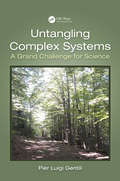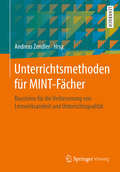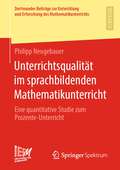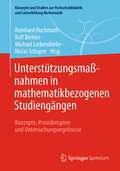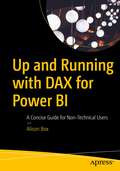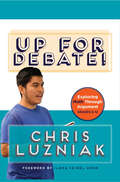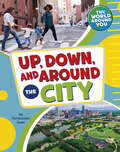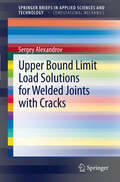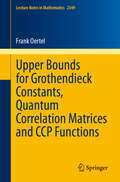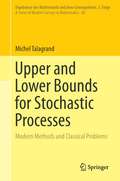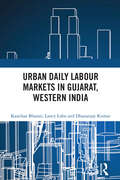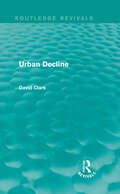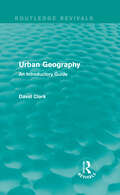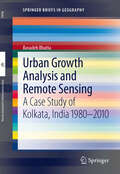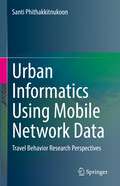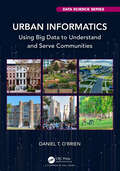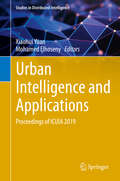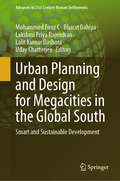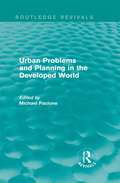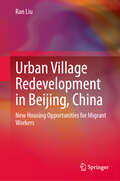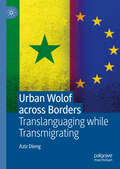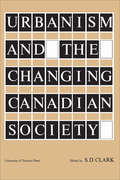- Table View
- List View
Unsupervised Learning with R
by Erik Rodriguez PachecoWork with over 40 packages to draw inferences from complex datasets and find hidden patterns in raw unstructured data About This Book * Unlock and discover how to tackle clusters of raw data through practical examples in R * Explore your data and create your own models from scratch * Analyze the main aspects of unsupervised learning with this comprehensive, practical step-by-step guide Who This Book Is For This book is intended for professionals who are interested in data analysis using unsupervised learning techniques, as well as data analysts, statisticians, and data scientists seeking to learn to use R to apply data mining techniques. Knowledge of R, machine learning, and mathematics would help, but are not a strict requirement. What You Will Learn * Load, manipulate, and explore your data in R using techniques for exploratory data analysis such as summarization, manipulation, correlation, and data visualization * Transform your data by using approaches such as scaling, re-centering, scale [0-1], median/MAD, natural log, and imputation data * Build and interpret clustering models using K-Means algorithms in R * Build and interpret clustering models by Hierarchical Clustering Algorithm's in R * Understand and apply dimensionality reduction techniques * Create and use learning association rules models, such as recommendation algorithms * Use and learn about the techniques of feature selection * Install and use end-user tools as an alternative to programming directly in the R console In Detail The R Project for Statistical Computing provides an excellent platform to tackle data processing, data manipulation, modeling, and presentation. The capabilities of this language, its freedom of use, and a very active community of users makes R one of the best tools to learn and implement unsupervised learning. If you are new to R or want to learn about unsupervised learning, this book is for you. Packed with critical information, this book will guide you through a conceptual explanation and practical examples programmed directly into the R console. Starting from the beginning, this book introduces you to unsupervised learning and provides a high-level introduction to the topic. We quickly move on to discuss the application of key concepts and techniques for exploratory data analysis. The book then teaches you to identify groups with the help of clustering methods or building association rules. Finally, it provides alternatives for the treatment of high-dimensional datasets, as well as using dimensionality reduction techniques and feature selection techniques. By the end of this book, you will be able to implement unsupervised learning and various approaches associated with it in real-world projects. Style and approach This book takes a step-by-step approach to unsupervised learning concepts and tools, explained in a conversational and easy-to-follow style. Each topic is explained sequentially, explaining the theory and then putting it into practice by using specialized R packages for each topic.
Untangling Complex Systems: A Grand Challenge for Science
by Pier GentiliComplex Systems are natural systems that science is unable to describe exhaustively. Examples of Complex Systems are both unicellular and multicellular living beings; human brains; human immune systems; ecosystems; human societies; the global economy; the climate and geology of our planet. This book is an account of a marvelous interdisciplinary journey the author made to understand properties of the Complex Systems. He has undertaken his trip, equipped with the fundamental principles of physical chemistry, in particular, the Second Law of Thermodynamics that describes the spontaneous evolution of our universe, and the tools of Non-linear dynamics. By dealing with many disciplines, in particular, chemistry, biology, physics, economy, and philosophy, the author demonstrates that Complex Systems are intertwined networks, working in out-of-equilibrium conditions, which exhibit emergent properties, such as self-organization phenomena and chaotic behaviors in time and space.
Unterrichtsmethoden für MINT-Fächer
by Andreas ZendlerMathematik, Informatik, Naturwissenschaften (Biologie, Chemie, Physik) und Technik - seit Jahren findet in der breiten Öffentlichkeit eine angeregte Diskussion über diese sogenannten MINT-Fächer statt. Denn das in den MINT-Fächern vermittelte Wissen ist die unverzichtbare Grundlage für die Ausbildung der in Deutschland dringend benötigten Fachkräfte. Darum fordern Politik und Wirtschaft eine stärkere Gewichtung der Fächer, aber auch eine Verbesserung der Unterrichtsqualität. Dieses Buch stellt 20 verschiedene, wissenschaftlich fundierte Methoden für den MINT-Unterricht vor und erläutert die Rolle der digitalen Medien als fächerübergreifendes Element. Die interdisziplinäre Betrachtungsweise bietet Lehrern einen umfassenden Überblick über die verschiedenen Möglichkeiten und Ansätze für den eigenen Unterricht. Für jede der vorgestellten Methoden geben die Autoren wissenschaftliche fundierte Einschätzungen zu ihrer Lerneffektivität und erleichtern so Lehrkräften die Auswahl der geeignetsten Methoden für den eigenen Unterricht. Detaillierte Unterrichtsmodelle helfen bei der Umsetzung in der Praxis. Damit erhalten Lehrer und Lehramtsstudenten einen umfassenden Einblick in die effektivsten Unterrichtsmodelle für ein prozess- und ergebnisorientiertes Lernen in den MINT-Fächern. Dieses Buch lässt sich ideal fächerübergreifend einsetzen und dient dazu, die Lerneffektivität speziell im MINT-Unterricht bei Schülerinnen und Schülern zu verbessern.
Unterrichtsqualität im sprachbildenden Mathematikunterricht: Eine quantitative Studie zum Prozente-Unterricht (Dortmunder Beiträge zur Entwicklung und Erforschung des Mathematikunterrichts #48)
by Philipp NeugebauerZiel dieser Arbeit ist die Entwicklung und Anwendung eines Instruments zur Erfassung der Unterrichtsqualität von sprachbildendem Unterricht. Dazu wird das Erfassungsinstrument L-TRU durch Adaption des TRU-Frameworks entwickelt, nachdem der Stand der Instrumente zur Erfassung von Unterrichtsqualität im Hinblick auf Sprachbildung im Mathematikunterricht aufgearbeitet wurde. Die Unterrichtsqualitätsdimensionen lassen sich (trotz naheliegender inhaltlicher Abhängigkeiten) als inhaltlich relevante und empirisch nicht komplett zusammenfallende Größen identifizieren. Besonders die neu ergänzten Dimensionen des L-TRU ermöglichen die Erfassung weiterer Phänomene, die bisher nicht berücksichtigt wurden. Einige dieser Unterrichtsqualitätsdimensionen erweisen sich sogar bei gleichem Unterrichtsmaterial als signifikante Einflussfaktoren auf den Lernzuwachs der Lernenden. Insgesamt trägt dieses Buch dazu bei, die qualitative Beforschung des sprachbildenden Unterrichts unter Rückgriff auf Methoden der Unterrichtsqualitätsforschung auch quantitativ anzureichern. Damit wird erreicht, Hypothesen zu Gelingensbedingungen für sprachbildenden Mathematikunterricht nicht mehr nur in Fallstudien qualitativ zu generieren, sondern in mehr Klassen auch quantitativ überprüfen zu können.
Unterstützungsmaßnahmen in mathematikbezogenen Studiengängen: Konzepte, Praxisbeispiele und Untersuchungsergebnisse (Konzepte und Studien zur Hochschuldidaktik und Lehrerbildung Mathematik)
by Reinhard Hochmuth Niclas Schaper Rolf Biehler Michael LiebendörferDie Gestaltung und Wirkung mathematikbezogener Unterstützungsmaßnahmen für Studierende vor Beginn des Studiums und während des ersten Studienjahrs beschäftigt nicht nur die an den Hochschulen lehrenden Mathematiker*innen, sondern auch Fachdidaktiker*innen, Hochschuldidaktiker*innen, Hochschulleitungen sowie die Bildungspolitik. Die Beiträge dieses Bandes resultieren aus einer langjährigen engen Kooperation zwischen Lehrenden aus 17 Universitäten und dem WiGeMath-Team. Den Mittelpunkt bilden konkrete Darstellungen einschlägiger Good-Practice-Beispiele, deren Ziele und Gestaltung jeweils um Evaluationsergebnisse ergänzt werden. Darüber hinaus finden sich praxisorientierte Überblickskapitel zu zentralen im WiGeMath-Projekt entwickelten Instrumenten: ein Rahmenmodell, das u. a. der systematischen Einordnung und Reflektion konkreter Maßnahmen dient, und ein Inventar bewährter quantitativer Erhebungsinstrumente. Ergänzend werden die am häufigsten umgesetzten Maßnahmentypen Vorkurse, Brückenvorlesungen und Lernzentren in informativen Kapiteln hinsichtlich ihrer jeweiligen Charakteristika und Wirkungen vorgestellt. Damit trägt der vorliegende Band dazu bei, folgende Fragen zu beantworten:Welche Gestaltungsmöglichkeiten von Vorkursen, Brückenvorlesungen und Lernzentren gibt es, und welche haben sich bewährt?Was weiß man über Wirkungszusammenhänge?Wie lassen sich mathematikbezogene Unterstützungsmaßnahmen evaluieren, und welche Instrumente zur Evaluation mathematikbezogener Unterstützungsmaßnahmen stehen aktuell zur Verfügung?Welche zentralen Fragen sind derzeit offen und bedürfen weiterer Forschung?Auf ein ausführliches Skalenhandbuch der Erhebungsinstrumente des Projekts WiGeMath kann über https://www.khdm.de/publikationen zugegriffen werden. Es dokumentiert insbesondere psychometrische Eigenschaften der Instrumente und stellt auf Basis der WiGeMath-Erhebungen Vergleichsdaten zur Verfügung und bietet damit eine Möglichkeit selbst erhobene Datensätze einzuordnen.
Up and Running with DAX for Power BI: A Concise Guide for Non-Technical Users
by Alison BoxTake a concise approach to learning how DAX, the function language of Power BI and PowerPivot, works. This book focuses on explaining the core concepts of DAX so that ordinary folks can gain the skills required to tackle complex data analysis problems. But make no mistake, this is in no way an introductory book on DAX. A number of the topics you will learn, such as the concepts of context transition and table expansion, are considered advanced and challenging areas of DAX.While there are numerous resources on DAX, most are written with developers in mind, making learning DAX appear an overwhelming challenge, especially for those who are coming from an Excel background or with limited coding experience. The reality is, to hit the ground running with DAX, it’s not necessary to wade through copious pages on rarified DAX functions and the technical aspects of the language. There are just a few mandatory concepts that must be fully understood before DAX can be mastered. Knowledge of everything else in DAX is built on top of these mandatory aspects. Author Alison Box has been teaching and working with DAX for over eight years, starting with DAX for PowerPivot, the Excel add-in, before moving into the Power BI platform. The guide you hold in your hands is an outcome of these years of experience explaining difficult concepts in a way that people can understand. Over the years she has refined her approach, distilling down the truth of DAX which is “you can take people through as many functions as you like, but it’s to no avail if they don’t truly understand how it all works.” You will learn to use DAX to gain powerful insights into your data by generating complex and challenging business intelligence calculations including, but not limited to:Calculations to control the filtering of information to gain better insight into the data that matters to youCalculations across dates such as comparing data for the same period last year or the previous periodFinding rolling averages and rolling totalsComparing data against targets and KPIs or against average and maximum valuesUsing basket analysis, such as “of customers who bought product X who also bought product Y”Using “what if” analysis and scenariosFinding “like for like” salesDynamically showing TopN/BottomN percent of customers or products by salesFinding new and returning customers or sales regions in each month or each year Who This Book Is ForExcel users and non-technical users of varying levels of ability or anyone who wants to learn DAX for Power BI but lacks the confidence to do so
Up for Debate!: Exploring Math Through Argument
by Chris LuzniakIn Up for Debate!: Exploring Math Through Argument, high school math teacher and debate coach Chris Luzniak shares stories, examples, and step-by-step routines that will help you build a classroom culture where students do the talking, explain their thinking, and critique each other's reasoning, all in the context of the math content you're expected to teach. Inside, you'll find: Inspirational stories of students debating math in real classroomsConcrete structures and routines that will get your students talking, listening, and debatingSpecific techniques you can use to transform existing math problems into debatable ones You'll begin with short speaking and listening routines that take just a few minutes to introduce. When you and your students are ready, you can layer on additional debate routines, until your class is engaged in full-class debates using mathematical reasoning. With this easy-to-read guide, you don't need to wait any longer. You will be able to start debating in your classroom, tomorrow.
Up for Debate!: Exploring Math Through Argument
by Chris LuzniakIn Up for Debate!: Exploring Math Through Argument, high school math teacher and debate coach Chris Luzniak shares stories, examples, and step-by-step routines that will help you build a classroom culture where students do the talking, explain their thinking, and critique each other's reasoning, all in the context of the math content you're expected to teach. Inside, you'll find: Inspirational stories of students debating math in real classrooms Concrete structures and routines that will get your students talking, listening, and debating Specific techniques you can use to transform existing math problems into debatable ones You'll begin with short speaking and listening routines that take just a few minutes to introduce. When you and your students are ready, you can layer on additional debate routines, until your class is engaged in full-class debates using mathematical reasoning. With this easy-to-read guide, you don't need to wait any longer. You will be able to start debating in your classroom, tomorrow.
Up, Down, and Around the City (The World Around You)
by Christianne JonesZoom! The elevator zips from the bottom floor to the top floor of a tall building. Beep! Beep! The subway stops for people to get on and off. Using bright photographs and interactive, rhyming text, this picture book will help young readers discover position words while exploring the city.
Upper Bound Limit Load Solutions for Welded Joints with Cracks
by Sergey AlexandrovThe present short monograph concerns analytic and semi-analytic techniques for finding an approximate value of the limit load. The limit load is an essential input parameter of flaw assessment procedures. In most cases, finding the limit load involves some numerical calculations of different levels of complexity, including numerical minimization of functions of one or several arguments, the slip-line technique and the finite element method. This book shows in particular how to use singular behavior of the real velocity field in the vicinity of bi-material interfaces in kinematically admissible velocity fields to increase the accuracy of upper bound solutions. An approach to recalculate the limit load for a class of structures with defects with the use of its value for the corresponding structure with no defect is discussed. The upper bound technique is applied to evaluate the limit load of overmatched and undermatched welded joints with cracks subject to various loading conditions of practical importance in conjunction with the aforementioned special techniques.
Upper Bounds for Grothendieck Constants, Quantum Correlation Matrices and CCP Functions (Lecture Notes in Mathematics #2349)
by Frank OertelThis book concentrates on the famous Grothendieck inequality and the continued search for the still unknown best possible value of the real and complex Grothendieck constant (an open problem since 1953). It describes in detail the state of the art in research on this fundamental inequality, including Krivine's recent contributions, and sheds light on related questions in mathematics, physics and computer science, particularly with respect to the foundations of quantum theory and quantum information theory. Unifying the real and complex cases as much as possible, the monograph introduces the reader to a rich collection of results in functional analysis and probability. In particular, it includes a detailed, self-contained analysis of the multivariate distribution of complex Gaussian random vectors. The notion of Completely Correlation Preserving (CCP) functions plays a particularly important role in the exposition.The prerequisites are a basic knowledge of standard functional analysis, complex analysis, probability, optimisation and some number theory and combinatorics. However, readers missing some background will be able to consult the generous bibliography, which contains numerous references to useful textbooks. The book will be of interest to PhD students and researchers in functional analysis, complex analysis, probability, optimisation, number theory and combinatorics, in physics (particularly in relation to the foundations of quantum mechanics) and in computer science (quantum information and complexity theory).
Upper and Lower Bounds for Stochastic Processes
by Michel TalagrandThe book develops modern methods and in particular the "generic chaining" to bound stochastic processes. This methods allows in particular to get optimal bounds for Gaussian and Bernoulli processes. Applications are given to stable processes, infinitely divisible processes, matching theorems, the convergence of random Fourier series, of orthogonal series, and to functional analysis. The complete solution of a number of classical problems is given in complete detail, and an ambitious program for future research is laid out.
Urban Daily Labour Markets in Gujarat, Western India
by Dhananjay Kumar Kanchan Bharati LANCY LOBOThis volume explores one of the most complex labour landscapes of India - the urban daily labour market. These markets form an important sector of the urban informal labour market and contribute significantly to the Indian economy. This book presents an empirical, comparative picture of daily labour markets, in Gujarat, Western India. These markets consist mostly of intra-state and interstate migrant workers who suffer from layered multiple marginalities based on markers of informality, migrant status, caste, ethnicity, gender and poor agency and often live in the peripheries of the cities without any rights and entitlements to their spaces and services. This study, based on an extensive survey of three cities in Gujarat, contains descriptions and analyses of the places of migration and their causes as well as the working and living conditions of the workers along with their spending patterns on food, health, education and leisure. It mirrors the work, life and issues of these workers on the regional level while contributing to a better understanding for future policy interventions. An in-depth study, the book will be of interest to students and researchers of labour economics, labour studies, urban planning, social work, sociology, anthropology, and demography. It will also be useful to NGOs/trade unions working with migrant workers, civil servants in Labour department and other related departments, city planners and policy makers.
Urban Decline: The British Experience (Routledge Revivals)
by David ClarkIn the twentieth century, urban growth was one of the most powerful catalysts of geographical, social and demographic change in the Western world. When this book was first published in 1989, however, a massive process of counter-urbanization was underway, which saw the loss of population and jobs in cities and a pronounced urban to rural shift. This book analyses the causes and consequences of urban decline in Britain and the developed world during this period and beyond, and assesses the implications for urban planning and policy. David Clark’s relevant and comprehensive title will be of value to students with a particular interest in urban geography and development.
Urban Geography: An Introductory Guide (Routledge Revivals)
by David ClarkThis book, first published in 1982, addressed the need for a fresh and comprehensive guide to the rapidly expanding area of urban geography. Drawing on examples from cities in a number of countries, including the U.S.A., David Clark outlines the contribution of geographers to the understanding of the city and urban society, and analyses the growth of the urban environment alongside planning and policy. A thorough and unique study, this title will be of particular value to undergraduate students, as well as laying the foundations for a more advanced study in urban geography and planning.
Urban Growth Analysis and Remote Sensing
by Basudeb BhattaThis book documents research conducted on the analysis of urban growth and sprawl by using remote sensing data and GIS techniques. The research was conducted between 1980-2010 in the city of Kolkata, India. The aim of the research was to use metrics that were less demanding in terms of data and computation than normal metrics. However, it has been found that most of them were inferior in capturing insights of urban sprawl. For this book, some of these metrics have therefore been modified and new ones are proposed. The research focuses on problems associated with the analysis of urban growth by using remote sensing data from a technological perspective.
Urban Informatics Using Mobile Network Data: Travel Behavior Research Perspectives
by Santi PhithakkitnukoonThis book discusses the role of mobile network data in urban informatics, particularly how mobile network data is utilized in the mobility context, where approaches, models, and systems are developed for understanding travel behavior. The objectives of this book are thus to evaluate the extent to which mobile network data reflects travel behavior and to develop guidelines on how to best use such data to understand and model travel behavior. To achieve these objectives, the book attempts to evaluate the strengths and weaknesses of this data source for urban informatics and its applicability to the development and implementation of travel behavior models through a series of the authors’ research studies.Traditionally, survey-based information is used as an input for travel demand models that predict future travel behavior and transportation needs. A survey-based approach is however costly and time-consuming, and hence its information can be dated and limited to a particular region. Mobile network data thus emerges as a promising alternative data source that is massive in both cross-sectional and longitudinal perspectives, and one that provides both broader geographic coverage of travelers and longer-term travel behavior observation. The two most common types of travel demand model that have played an essential role in managing and planning for transportation systems are four-step models and activity-based models. The book’s chapters are structured on the basis of these travel demand models in order to provide researchers and practitioners with an understanding of urban informatics and the important role that mobile network data plays in advancing the state of the art from the perspectives of travel behavior research.
Urban Informatics: Using Big Data to Understand and Serve Communities (Chapman & Hall/CRC Data Science Series)
by Daniel T. O'BrienUrban Informatics: Using Big Data to Understand and Serve Communities introduces the reader to the tools of data management, analysis, and manipulation using R statistical software. Designed for undergraduate and above level courses, this book is an ideal onramp for the study of urban informatics and how to translate novel data sets into new insights and practical tools. The book follows a unique pedagogical approach developed by the author to enable students to build skills by pursuing projects that inspire and motivate them. Each chapter has an Exploratory Data Assignment that prompts readers to practice their new skills on a data set of their choice. These assignments guide readers through the process of becoming familiar with the contents of a novel data set and communicating meaningful insights from the data to others. Key Features: The technical curriculum consists of both data management and analytics, including both as needed to become acquainted with and reveal the content of a new data set. Content that is contextualized in real-world applications relevant to community concerns. Unit-level assignments that educators might use as midterms or otherwise. These include Community Experience assignments that prompt students to evaluate the assumptions they have made about their data against real world information. All data sets are publicly available through the Boston Data Portal.
Urban Intelligence and Applications: Proceedings of ICUIA 2019 (Studies in Distributed Intelligence)
by Mohamed Elhoseny Xiaohui YuanThis volume presents selected papers from the International Conference on Urban Intelligence and Applications (ICUIA), which took place on May 10-12, 2019 in Wuhan, China. The goal of the conference was to bring together researchers, industry leaders, policy makers, and administrators to discuss emerging technologies and their applications to advance the design and implementation of intelligent utilization and management of urban assets, and thus contributing to the autonomous, reliable, and efficient operation of modern, smart cities. The papers are collated to address major themes of urban sustainability, urban infrastructure and management, smart city applications, image and signal processing, natural language processing, and machine learning for monitoring and communications applications. The book will be of interest to researchers and industrial practitioners working on geospatial theories and tools, smart city applications, urban mobility and transportation, and community well-being and management.
Urban Planning and Design for Megacities in the Global South: Smart and Sustainable Development (Advances in 21st Century Human Settlements)
by Bharat Dahiya Lakshmi Priya Rajendran Uday Chatterjee Mohammed Firoz C Lalit Kumar DashoraThis anthology, Urban Planning and Design for Megacities in the Global South: Smart and Sustainable Development, sheds light on the intricate dynamics of megacity growth in the Global South. It has compiled a rich and diverse array of evidence-based case studies, fostering discussions on emerging issues, strategies, and solutions for the enhanced planning and development of megacities in the Global South. By delving into the underlying factors propelling this rapid urban expansion, such as economic opportunities, rural-to-urban migration, and natural population growth, this volume analyzes the complex interplay of socio-economic, environmental, and political forces shaping city-regional landscapes. Examining the growth of megacities offers invaluable insights into the challenges and opportunities associated with urbanization in the 21st century. Furthermore, some cities that have not yet achieved megacity status have also been included in this book to provide a comprehensive understanding of urban growth dynamics and the related factors influencing this growth. By studying these rapidly expanding cities, their challenges in urban planning and policy implementation can be identified. These challenges often include inadequate infrastructure, insufficient public services, environmental degradation, and socio-economic disparities. In response, using case studies, the book presents conceptual and empirical strategies to tackle the various problems faced by megacities of the Global South.
Urban Problems and Planning in the Developed World (Routledge Revivals)
by Michael PacioneThis edited collection, first published in 1981, presents a discussion of the urban problems faced in the developed world, and addresses the plans and policies devised by governments to solve them. Using a number of city-based case studies, including New York, Tokyo and Glasgow, the authors present a thorough analysis of urban problems and planning in relation to varying economic, cultural and political conditions throughout the developed world. With a detailed general survey from Michael Pacione, this is a comprehensive and relevant guide, which will be of particular value to students and scholars of urban planning and geography.
Urban Socio-Economic Segregation and Income Inequality: A Global Perspective (The Urban Book Series)
by Maarten Van Ham Tiit Tammaru Rūta Ubarevičienė Heleen JanssenThis open access book investigates the link between income inequality and socio-economic residential segregation in 24 large urban regions in Africa, Asia, Australia, Europe, North America, and South America. It offers a unique global overview of segregation trends based on case studies by local author teams. The book shows important global trends in segregation, and proposes a Global Segregation Thesis.Rising inequalities lead to rising levels of socio-economic segregation almost everywhere in the world. Levels of inequality and segregation are higher in cities in lower income countries, but the growth in inequality and segregation is faster in cities in high-income countries. This is causing convergence of segregation trends. Professionalisation of the workforce is leading to changing residential patterns. High-income workers are moving to city centres or to attractive coastal areas and gated communities, while poverty is increasingly suburbanising. As a result, the urban geography of inequality changes faster and is more pronounced than changes in segregation levels. Rising levels of inequality and segregation pose huge challenges for the future social sustainability of cities, as cities are no longer places of opportunities for all.
Urban Village Redevelopment in Beijing, China: New Housing Opportunities for Migrant Workers
by Ran LiuThe book provides a multi-stage assessment of the changing housing opportunities of migrant workers in the three stages of Beijing’s urban village development (emergence, erasure and preservation). The volume re-theorizes Henry Lefebvre’s notion of the “right to the city” as a largely property-based concept that falls within the city’s hybrid tenure matrix of varying degrees of tenure security and formality that is undergoing entrepreneurialization or gentrification. This is another highly valuable contribution to China studies from the geographical perspective of the “territorial politics” at play in the process of urban village redevelopment, which has fostered a new propertied landowning class as winners, while moving low-wage migrants. The book takes the reader on a fascinating journey from peri-urban villages to IT worker villages to artists’ villages, revealing a restless landscape of urbanism and state-centered governance, as well as bottom-up counterplots. The fieldwork explores the contradictions of urban village redevelopment in Beijing. On the one hand, it is state-dominated and yet creates new housing opportunities for migrants; on the other, it disrupts old orders but also encourages new forms of grassroots alliances. The empirical studies of Beijing’s urban villages enrich Henry Lefebvre’s discourse on “planetary urbanisation,” Gilles Deleuze and Félix Guattari’s notion of the “rhizome,” and Elinor Ostrom’s ideas on the wise management of the “commons.”
Urban Wolof across Borders: Translanguaging while Transmigrating
by Aziz DiengThis book takes urban Wolof beyond Senegal to consider the effects of mobility on language and examine how the diasporans engage in their daily language practices as transmigrants. The parallel between languaging and migrating underpins the author's argument, as he examines the dynamicity of languaging at both micro and macro levels, as speakers navigate across spaces and languages. Moving away from a code-based approach, the author makes a compelling case that the urbanite, rather than shuttling between codes, deploys instead idiolectal features from a unique linguistic repertoire which comprises at once semiotic, cognitive, and language features. His indigenous approach affords novel perspectives in linguistic ethnography and complements the Euro-Western methodologies.
Urbanism and the Changing Canadian Society
by S. D. ClarkIn this collection of essays the changing structure of the Canadian community, especially in its urban growth, is brought before the reader with many fresh insights, much vigorous comment, and apt illustration. The authors, concentrating on certain kinds of problems which have interested them individually, provide for student and general reader stimulating analysis of social phenomena which are under lively examination these days in Canada and beyond both in popular and semi-popular journals and magazines and in learned writings.Nathan Keyfitz opens the volume with a valuable background analysis of the way in which the population of Canada has reached its present numbers and distribution and examines the effects of immigration and of changing rates of birth and death. S.D. Clark deals with the controversial question of what the real characteristics of the suburban community can be seen to be and comments forcefully on the "suburbia" of Riesman, Whyte, et al. W.E. Mann presents a fascinating analysis of the patterns of life in a slum area of Toronto which swarms with factory workers and truck-drivers, with people of many racial origins, and which has developed social habits based largely on rooming-houses, small shops, and pubs. Jean Burnet provides an historical account of changing moral standards of sobriety and piety as reflected in sabbatarian and temperance movements in Toronto, long regarded as the quintessence of severity. Oswald Hall gives a valuable analysis of the patterns of growth in the professions and of the kinds of competitive struggles going on within them and at the borders between them as new groups strive to win this status in society. P.J. Giffen takes up an important related question of how interests of a self-governing profession relate to the expectations of the public and uses the legal profession as his example. Finally, Leo Zakuta adds to the scanty literature on Canadian political parties an analysis of the changing character of the C.C.F., long the dominant force in left-of-centre politics.The authors all are, or have been members of the staff in sociology at the University of Toronto, and their essays convey an excellent picture of the liveliness of the work they jointly carry forward. This volume will thus serve not only to introduce students to some of the kinds of problems sociologists are thinking about but will also make better known to them as a group some of the sociologists in Canada who are engaged with them.

